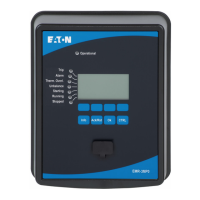3.4 Probus
Conguration of the Devices
After selecting Probus as the SCADA protocol (via setting [Device Planning] »Protocol« =
“Probus”), enter the menu branch [Device Para / Probus] ; there you have to set the
following communication parameter:
• »Slave ID«, to allow clear identication of the device This is a number from 2 to 125,
which must be unique among all Probus devices in the network.
In addition to that the Master has to be provided with the GSD-le. The GSD-le can be
taken from the Product-CD.
Some more (Probus-related) parameters that might be interesting are listed in the
Reference Manual.
CAUTION!
The trip signals are not part of the default conguration of the Probus protocol!
If it is required that trip signals are reported via Probus you have to explicitly assign
them to some Congurable Binary Input. For example, you have to make settings like the
following one:
[Device Para / Probus / Cong Bin Inp xx‑yy] »Cong Bin Inp zz« = “50P . Trip”
Hardware Connection
• The hardware connection to the control system depends on the ordered hardware
variant (see ╚═▷ “Catalog Codes for the EMR-3MP0”, ╚═▷ “Communication Protocol
Codes”): At the rear side of the EMR-3MP0, there is either an RS485 (D-SUB)
interface or an optic ber (ST connector) interface available for the Probus
connection.
• Connect bus and EMR-3MP0.
• Up to 123 Slaves can be connected.
•
In case of a D-SUB interface, terminate the Bus by means of an Terminate Resistor.
Error Handling
Information on physical communication errors (e. g. the detected baud rate) can be
obtained from the Event Recorder (see ╚═▷ “Event Recorder”) or the status display (menu
branch [Operation / Status Display]).
Error Handling – D-SUB Status LED
The Probus D-SUB interface at the rear side of the device is equipped with an status
LED.
• Baud Search — red ashing
116 www.eaton.com EMR-3MP0
3 Communication Protocols
3.4 Probus

